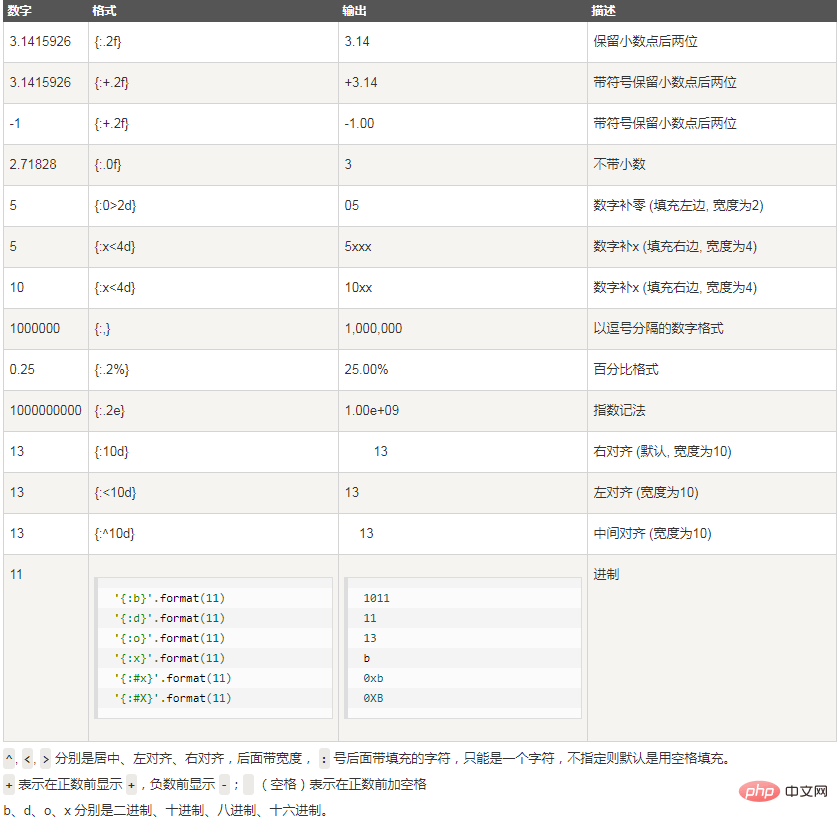本文摘自php中文网,作者爱喝马黛茶的安东尼,侵删。
Python2.6 开始,新增了一种格式化字符串的函数 str.format(),它增强了字符串格式化的功能。基本语法是通过 {} 和 : 来代替以前的 % 。
format 函数可以接受不限个参数,位置可以不按顺序。

format格式化函数
实例
1 2 3 4 5 6 | >>>"{} {}".format("hello", "world") # 不设置指定位置,按默认顺序
'hello world'
>>> "{0} {1}".format("hello", "world") # 设置指定位置
'hello world'
>>> "{1} {0} {1}".format("hello", "world") # 设置指定位置
'world hello world'
|
也可以设置参数:
相关推荐:《Python视频教程》
实例
1 2 3 4 5 6 7 8 9 | #!/usr/bin/python
# -*- coding: UTF-8 -*-
print("网站名:{name}, 地址 {url}".format(name="php中文网", url="www.php.cn"))
# 通过字典设置参数
site = {"name": "php中文网", "url": "www.php.cn"}
print("网站名:{name}, 地址 {url}".format(**site))
# 通过列表索引设置参数
my_list = ['php中文网', 'www.php.cn']
print("网站名:{0[0]}, 地址 {0[1]}".format(my_list)) # "0" 是必须的
|
输出结果为:
1 2 3 | 网站名:php中文网, 地址 www.php.cn
网站名:php中文网, 地址 www.php.cn
网站名:php中文网, 地址 www.php.cn
|
也可以向 str.format() 传入对象:
实例
1 2 3 4 5 6 7 | #!/usr/bin/python#
-*- coding: UTF-8 -*-
class AssignValue(object):
def __init__(self, value):
self.value = value
my_value = AssignValue(6)
print('value 为: {0.value}'.format(my_value)) # "0" 是可选的
|
输出结果为:
数字格式化
下表展示了 str.format() 格式化数字的多种方法:
1 2 | >>> print("{:.2f}".format(3.1415926));
3.14
|

此外我们可以使用大括号 {} 来转义大括号,如下实例:
实例
1 2 3 | #!/usr/bin/python
# -*- coding: UTF-8 -*-
print ("{} 对应的位置是 {{0}}".format("php"))
|
输出结果为:
php 对应的位置是 {0}
以上就是python的format函数是什么意思的详细内容,更多文章请关注木庄网络博客!!
相关阅读 >>
Python tkinter是什么
Python中怎么查看内置函数
Python 矩阵增加一行或一列的实例_Python
Python图像处理二值化方法实例云集
Python适合做什么开发?
Python中set集合属于可变类型吗
Python建议每行最多容纳多少字符
解决Python 输出是省略号的问题
深入了解Python中的os模块
关于Python中的__init__与__new__以及__call__三个方法的简单介绍
更多相关阅读请进入《Python》频道 >>

人民邮电出版社
python入门书籍,非常畅销,超高好评,python官方公认好书。
转载请注明出处:木庄网络博客 » python的format函数是什么意思







